Evolution of Integrated Marketing Communications
New technical inventions have always served as a driver of the economy and social change, including the relationship between producers and consumers. The last decades of the previous century are characterized by the emergence of many new technologies and, consequently, new communication tools and channels (Payne, Peltier, and Barger, 2017, p. 2). Businesspersons immediately began to apply new technologies in marketing to strengthen customer relationships, generate more profit, and expand their influence in the markets. It led to the emergence of omnichannel marketing and Integrated Marketing Communications (IMC). In just thirty years, these two marketing concepts have become crucial and essential elements of almost any business model, anywhere in the world. Experts note that “the role of marketing communication cannot be neglected today, since it has become a compulsion for business survival” (Desai and Shah, 2019, p. 2). Understanding the history of IMC development is essential for one to analyze, evaluate, and develop practical and effective IMC strategies, approaches, and concepts competently.
IMC before Internet
IMC was defined and conceptualized as a marketing strategy in the early 90s. It happened “after Caywood, Schultz, and Wang (1991) published their first IMC article titled “Integrated marketing communications: A survey of National Goods Advertisers” (Ahmad and Mokhtar, 2019, p. 583). It began to be widely practiced by marketers only a few years later. According to Desai and Shah (2019, p. 3), “the concept of Integrated Marketing Communication started being accepted widely as an idea and technique since the mid-1990s.” IMC is ideologically originated from the concept of four traditional marketing areas, which are “Advertising, Direct Marketing, Sales Promotions, and Public relations” and “the idea of one voice, one sight and one sound for a brand” (Desai and Shah, 2019, p. 5). The subsequent emergence of cyberspace as a new method of public communication and online media channels has become a paradigm shift in the application of IMC.
IMC after Internet
Figure 1, A graph showing how much time people spend on TV and the Internet over the past decade (Desai and Shah, 2019, p. 6).
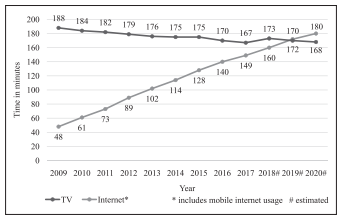
With online space available to everyone, it became possible for marketers to receive, analyze, and study customer preferences, responses, and feedback. Moreover, consumers can finally choose and filter information channels and express their opinion about certain brands directly and publicly (Desai and Shah, 2019, p. 5). As a result, the widely and easily accessible Internet has created two new marketing activities, namely digital marketing and personal selling. Digital marketing can be described as a process of promoting brands on the Internet space utilizing two-way interactive online communications (Key and Szaplewski, 2017, p. 5). According to Key and Czaplewski (2017, p. 5), “personal selling is best used to convert preference and conviction into behavior and relies heavily on the other elements of the promotions mix.” Gradually, the Internet and social media began to prevail over offline communication channels because the new online ones were more versatile, friendly, convenient, and less aggressive, and this change continues.
Today’s Status of IMC
The changes brought by the Internet to the IMC did not affect its definition. Economists argue that it “coordinates and manages the marketing communications” and “ensures consistent brand messages are used in every internal and external communication and promotes collaboration amongst all stakeholders” (Zoeller, 2021, para. 14). However, ongoing social and marketing processes can change the conventional academic interpretation of the IMC.
Nowadays, marketers face a big challenge as significant innovations in mobile technology made in the 00s created another big wave of societal and economic changes we witness now. Desai and Shah (2019, p. 5) note that “IMC is in a transition phase where the challenge is to integrate offline (traditional) channels with online (modern) channels.” This complex integration process implies two levels, which are population, and international. It is no secret that different generations prefer different communication channels. Older people like traditional ones while teenagers and young adults often use new ones to communicate and buy products and services. Moreover, the type of prevailing communication channel type varies from country to country, depending on cultural and religious nuances and economic and technological development. Such a state of affairs in marketing provides many opportunities for creating new IMC activities and approaches.
IMC’s Synchronization Function within Omni-Channel Marketing
IMC is crucial for the creation and maintenance of efficient synchronization in omnichannel marketing. When implemented, IMC ensures information consistency and interactivity across all communication channels (Payne, Peltier, and Barger, 2017, p. 5). It allows marketers to analyze consumer preferences and contacts, send and coordinate a unified message, and monitor its status through offline and online media. This is how IMC creates harmony and synergy in the marketing segment of the company, for which this particular strategy is very well known in the business environment.
The First Companies to Adopt the IMC Strategy and a New Generation of Businesses
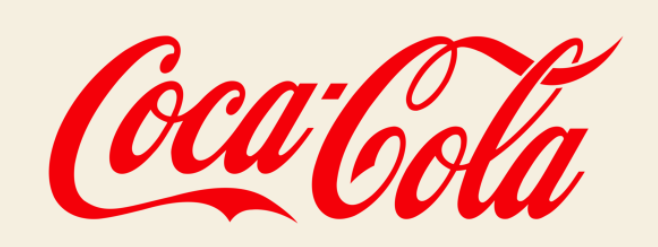
The pioneers in the practical application of IMC were large international corporations associated with the sale of beverages and information software and hardware. These companies are Coca-Cola and Datavail, Starbucks, and Rockwell Automation (Zoeller, 2021, para. 22). To be more specific, Coca-Cola uses IMC to portray its world-famous drinks as an integral and authentic element of people’s daily lives (AngelicaAndMrithula, 2019, para. 2). GoPro is one of the most notable examples of next-generation social media and mobile technology companies using IMC to promote their products (Zoeller, 2021, para. 22). It is impossible to run a flourishing enterprise of practically any type without the use of IMC.
Lancôme’s Performance in terms of IMC
Lancôme’s Advertising
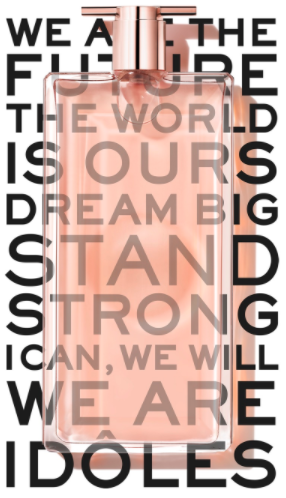
It should be noted that the company that was selected to analyze her performance in terms of her communication tools is Lancôme. Lancôme is a “global beauty brand” and “part of the L’Oréal Luxury Products division” that focuses on selling cosmetics products to wealthy people (Feldman, 2021, para. 3). Before the international pandemic that affected every country, Lancôme often organized interactive physical events to advertise its products (Feldman, 2021, para. 3). These were some of the top priority offline communication channels for the company. However, terms changed, and Lancôme had to adapt to a new business environment under government restrictions.
As one probably noticed, COVID-19 has not diminished customer demand; it has even increased in some areas. Lancôme and many other brands quickly adapted their online advertising strategies to the virtual format (Feldman, 2021, para. 5). The combination of programmatic advertising, retargeting, prospecting and rich virtual emasculation has allowed the company to achieve significant positive results in promoting luxury cosmetics. Marketers have achieved high online visitor numbers and engagement rates and increased brand and product awareness (Feldman, 2021, p. 12). It was an excellent result for a company that had not hosted any virtual events before and used the new microsite unknown to established and new audiences as its central platform. This case shows that Lancôme marketers are well aware of their offline and online advertising opportunities and resources and use them expertly.
Lancôme’s Sales Promotion
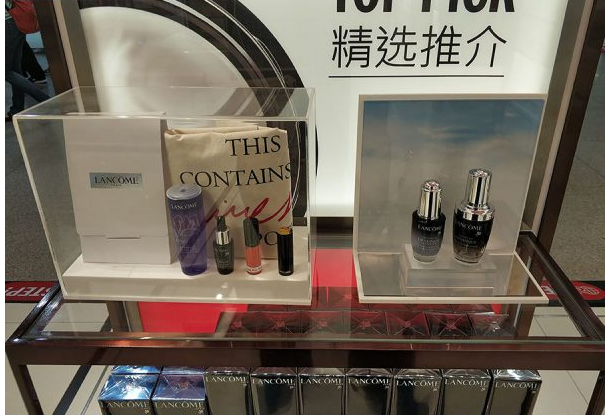
Lancôme mainly adheres to traditional methods of offline sales promotion, unlike in advertising. These include POS displays with unique designs and periodic free gift promotions. The former is a very cost-effective tactic for sales promotion as they are cheap, reusable, and ideally attract the attention of many consumers because they serve as a means of advertising multiple products of a single brand (The OMD Group, 2018, para. 4). Free gift promotion is the small price that companies pay to satisfy the desires of established customers and attract new ones(The OMD Group, 2018, para. 5). The consequence of applying these ICM approaches to traditional communication channels, in this case, is increased product sales (The OMD Group, 2018, para. 4). Therefore, Lancôme’s performance in this area of marketing can also be considered efficient.
Lancôme’s Direct Marketing
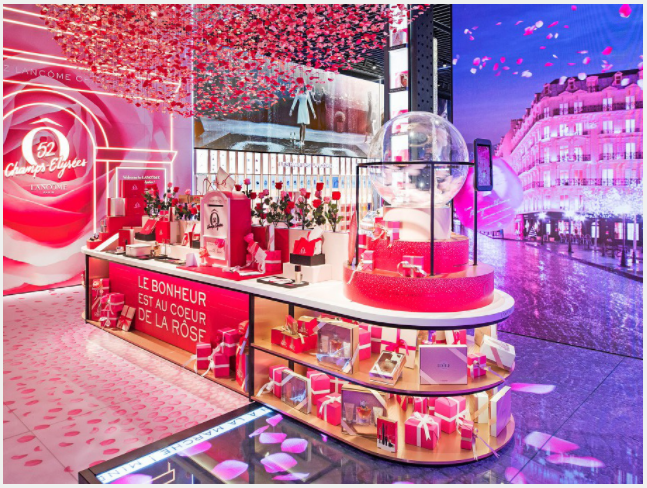
L’Oréal’s direct marketing analysis showed that the corporation and all its brands pay special attention to direct communication with customers, both in physical and online space, and Lancôme is no exception. Lancôme, like any other L’Oréal brand, provides consumers with a large number of exceptional online services and products. Lancôme’s e-commerce is one of the most personalized and custom-oriented in the beauty industry. Retail stores are also following this trend of personalizing the producer-consumer relationship. According to Agon (2019, para. 2), “inside, Lancôme offers consumers a host of bespoke services and tailor-made consultations.” Digital and offline services include online skin tests, and individualized, detailed instructions for cosmetic products (Agon, 2019, para. 1). Lancome even produces custom foundations following the customer’s requirements (Agon, 2019, para. 2). It is safe to say that Lancôme’s marketers are very good at direct marketing communication tools. They are also well aware of trends in the beauty industry and global market patterns common to all markets and timely implement innovative marketing models.
Lancôme’s Publicity
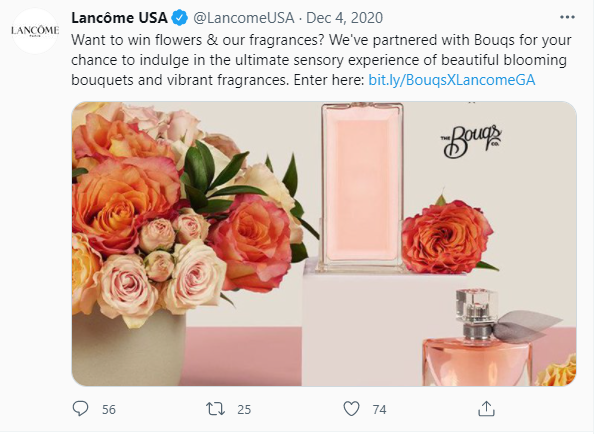
Lancôme’s public relations are also at a very high level, and her media impact is one of the most powerful in the online space. Cohen (2020, para. 1) notes that the company “has managed to stay consistently successful and month-on-month come out as one of the top beauty brands … in comparison to its competitors”. The secret to such PR success lies in two strategies, namely collaborating with social media influencers and focusing on communicating with the public.
The brand constantly collaborates with famous people, especially young people. When choosing an influencer, the company pays attention to the number of followers a person has and their media background and personal qualities (Cohen, 2020, para. 3). Moreover, Lancôme’s marketers focus on those social platforms with the liveliest interactions, namely Twitter (Cohen, 2020, para. 5). One of the biggest actors in the beauty industry communicates with his followers through product shots and short videos with inspiring phrases, quotes, or questions in the caption (Cohen, 2020, para. 5). The fact that Lancôme has successfully entered the online space and is constantly becoming a trending brand shows the PR department’s high productivity and well-developed professional skills.
Lancôme’s Personal Selling
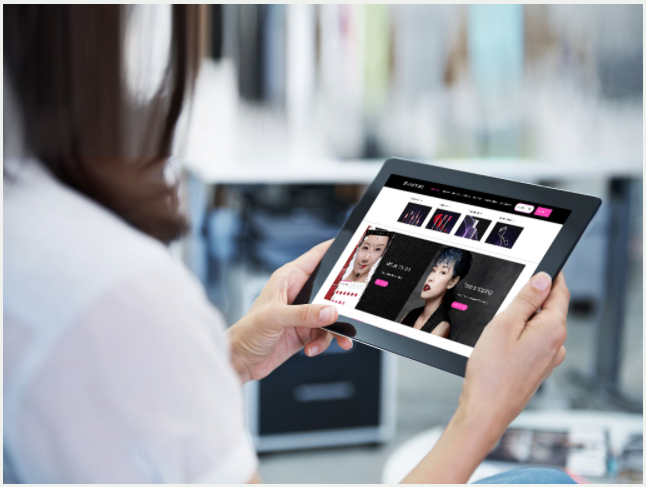
As noted above, Lancôme is a luxury brand, which means that personal selling is the top priority communication channel for their marketers. Previously in this work, it was mentioned that the company’s employees offer customers and newcomers many services both online and in retail stores. Lancôme workers do almost everything to ensure that their cosmetic products are suitable for consumers and serve them well. When interacting with customers, they act as salespeople, guides, advisors, and servants at the same time (Agon, 2019, para. 2). They also offer several types of treatments like a spa to make consumers feel as good as possible at Lancôme. As one can see, the company takes a comprehensive approach to personal selling, and the overall performance of this communicational channel is high.
Hong Kong Beauty Market IMC Plan for Lancôme
SOSTAC Model
One should base their IMC plan on a well-developed theoretical framework based on substantial scientific evidence for it to be practical and effective. One such planning guide is the SOSTAC model, which consists of six elements. Each of them will be analyzed here in relation to Lancôme. The target audience section has been added as it is also crucial for successfully implementing the IMC plan.
Target Audience
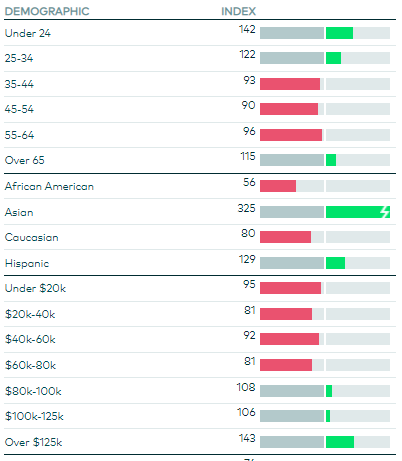
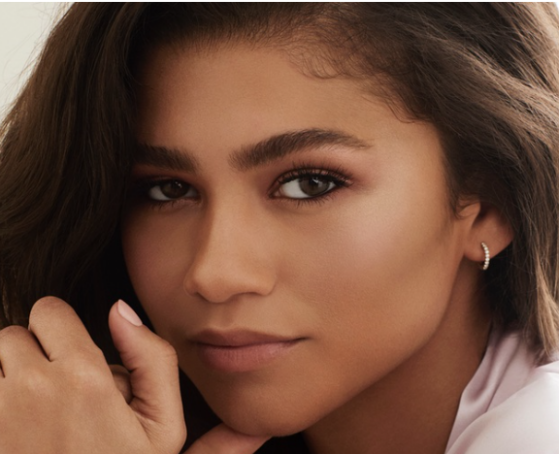
Before drawing up an IMC plan for the Hong Kong beauty market, one must first determine the target audience. The potential target audience for Lancôme in Hong Kong is similar to that in other countries. They are wealthy people over 25-30 years old, primarily women (Lancôme, no date, para. 1). It is important to note that Lancôme started a widespread advertising campaign among the younger generation a couple of years ago with Zendaya Coleman as the brand ambassador (Bargh, 2019, para. 2). Therefore, Hong Kong youth should also be considered the target audience for Lancôme beauty products. Marketers should also expect an increase in demand for skin care products from the male population. According to Smith (2020, para. 10), “thanks to K-pop, a genre of Korean pop music, flawless skin — natural or corrected by cosmetics — has become non-gender-specific.” Presumably, these socioeconomic trends will continue for at least another decade, which means more profits for the beauty industry and more intense competition.
Situational Analysis
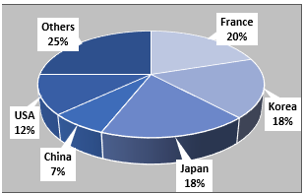
As mentioned above, Lancôme is one of the leading luxury brands of skincare and beauty products globally. In addition, the company and its owner already have a branch office in Hong Kong. Simply put, the intervention in the foreign market has already taken place successfully. What the company needs is an expansion in terms of publicity and market relations. The organization has significant experience in building positive public relations and an excellent understanding of old and new information channels and the nuances of operating them. Lancôme’s marketers have also previously collaborated with Chinese social media influencers, which means they know the social and cultural nuances of interacting with famous people in the region (Cohen, 2020, para. 6). However, one of the company’s internal weaknesses is its focus only on wealthy customers, which could negatively affect potential sales due to the economic downturn in Hong Kong caused by the global pandemic and local lockdown policies.
Hong Kong’s beauty market is unusual from a socioeconomic perspective. Hong Kong is among the richest regions globally; incomes and financial opportunities of citizens are also high there (Tognini. 2020, para. 6). However, the vast majority of beauty products here are middle-priced (Poon, 2020, para. 1). Such an environment enables Lancôme to stand out by offering higher quality world-class products effectively. In addition, France has about one-fifth of the beauty products market in Hong Kong, which means that L’Oréal can provide more resources for expansion, advertising, and promotion (Cosmetics and toiletries, 2021, para. 1). There are many foreign players in the city’s beauty industry, which means tough competition for the company (Cosmetics and toiletries, 2021, para. 1). The slight economic downturn mentioned earlier could scare some established customers and potential consumers away from luxury products. Overall, the Hong Kong beauty market seems very profitable for Lancôme, and further expansion is advised.
Communication Objectives
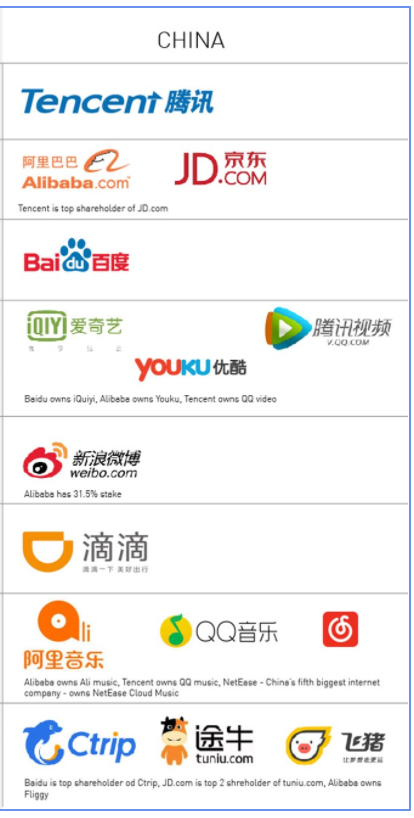
The Hong Kong beauty industry setting makes it possible to define several communication goals clearly. The first is to attract more publicity; all segments of the new target audience should be aware that unique and high-quality beauty products have entered the market. Another one is increasing customer engagement through international and local Chinese social media and websites. The third and final communication objective is to become one of the top actors in the beauty market in Hong Kong. It is expected that the developed measures will allow Lancôme to achieve the same positions that it has in Europe and the United States. Becoming a market leader is also a desirable result, especially given that the environment potentially allows it (Poon, 2020, para. 1). In any case, a highly successful outcome for Lancôme is expected.
Marketing Communication Strategy

The global pandemic has not yet passed, as the restrictive state policies in many regions and cities of the planet and Hong Kong is no exception. Therefore, it would be appropriate to use those strategies that have already proven their effectiveness. One of those, which recently, namely in April, was applied by Lancôme, is a programmatic strategy (Feldman, 2021, para. 6). It is no secret that people in developed Asian countries are even more integrated with social media than people from the Western Hemisphere. The vibrant and luxurious digital performance will catch the attention of many new customers. The positive impact would be even more substantial if you collaborate with local social media influencers associated with fashion, cosmetics, and skin routines. The influencer marketing strategy would be another helpful tool in the case of Hong Kong. The combination of these approaches would provide a powerful advertising and promotional campaign for the brand.
Tactics and Actions

The arsenal of tactics is also limited by the current COVID-19 pandemic and related policy measures. The first step will be to create brand accounts on major social networks in China and Hong Kong. The preference should be for a social media resource that involves intense interaction between users. The most appropriate option in such a case would be Sina Weibo, with which Lancôme already collaborated in the past (Cohen, 2020, para. 6). The company should use the same methods of communicating with followers and consumers as on Twitter. New ways of interaction that are more common and familiar to the Chinese and Hong Kong populations should also be adopted if they produce a positive media impact for Lancôme. Broad advertising of Lancôme’s products on TV is also advised.
The organization should also use the methods of traditional physical advertising that are already familiar to it, such as the use of POS displays and free promotion of cosmetic products. They directly increase product sales, so their implementation is crucial for the successful advertising campaign and IMC development. The issue of price is also should be emphasized when discussing the details of IMC. Up to $ 100,000,000 would be enough for the entire project. Experts note that “they spent under $100 million on advertising in digital, print, and national TV in the last year” (Lancôme Paris advertiser profile, no date, para. 1). However, one should expect that the Hong Kong setting might require slightly larger sums of money.
Evaluation and Control

The IMC’s proposed plan is a long-term project with significant investment. Events of this scale require monitoring and evaluation tools from the organizers. Key Performance Indicators (KPI) would be the best set of measurements for assessing the effectiveness and productivity of the implemented plan in this case (Twin, 2021, para. 1). KPIs were chosen as measurements because they make it possible for one to track and evaluate each process within the project at all levels of the organizational hierarchy. Another question is how often and by what means one should obtain, analyze and interpret all the necessary data. CRM software is a standard tool for completing such tasks in every business model in almost every part of the world (CRM org, 2019). Moreover, many of the CRM processes responsible for these functions are automated, allowing one to receive the necessary reports every day.
Reference List
Agon, J.-P. (2019) The direct-to-consumer channel: enhancing the luxury experience. Web.
Ahmad, A. and Mokhtar, S. S. M. (2019) ‘10 years of integrated marketing communication (IMC): A systematic literature review’, Journal of Advanced Research in Dynamical and Control Systems, 11(5). Web.
AngelicaAndMrithula (2019) ‘Coca-Cola: Current marketing communications strategy.’ Global Marketing Professor,.
Bargh, B. (2019) Lancôme targets a new generation of consumers with the first Gen-Z fragrance fronted by Zendaya Coleman. Web.
Cohen, J. (2020) #BBMoment: Lancôme’s millennial mindshare. Web.
Cosmetics and toiletries (2021) Web.
CRM org (2019) What is a CRM? Customer relationship management software (2021). Web.
Desai, A. and Shah, J. (2019) ‘Integrated marketing communication then and today – A challenge or an opportunity?’, Journal of Marketing Vistas, 9(1). Web.
Feldman, K. (2021) How Lancôme used programmatic advertising to uplift brand and drive virtual event signups. Web.
Key, T. M. and Czaplewski, A. J. (2017) ‘Upstream social marketing strategy: An integrated marketing communications approach’, Business Horizons, 60(3), pp. 325-333. Web.
Lancôme (no date) Web.
Lancôme Paris advertiser profile (no date) Web.
Lancôme USA (2009) [Twitter] February. Web.
Payne, E. M., Peltier, J. W. and Barger, V. A. (2017) ‘Omni-channel marketing, integrated marketing communications and consumer engagement: A research agenda’, Journal of Research in Interactive Marketing, 11(2), p. 1-21. Web.
Poon, C. H. (2020) Cosmetics and toiletries industry in Hong Kong. Web.
Smith, S. (2020) The rise of men’s cosmetics and brands making their mark. Web.
The OMD Group (2018) Lancôme shows us how cosmetics marketing is done! Web.
Tognini, G. (2020) ‘World’s richest cities: The top 10 cities billionaires call home’, Forbes. Web.
Twin, A. (2021) Key performance indicators (KPIs). Web.
Wade, M. R. (2017) The Chinese digital giants – coming to a store near you! Web.
Zoeller, S. (2021) ‘Why use an integrated marketing communications approach?’. Stephen Zoeller’s Marketing Blog.